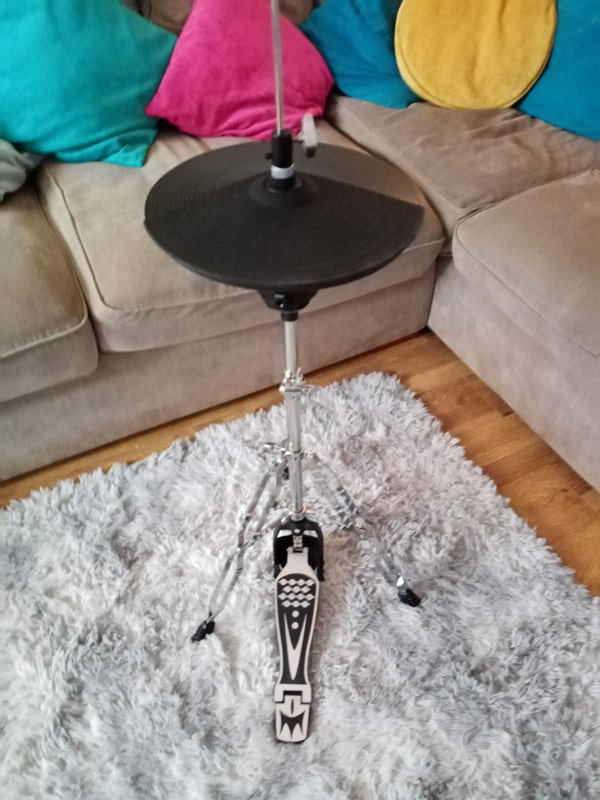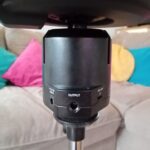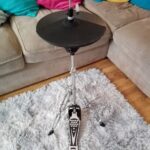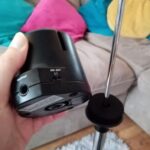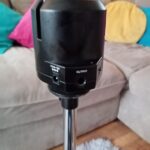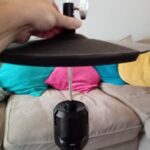Alesis Nitro Mesh or the Millenium MPS-850 Drumkit?
So, you are looking to buy a new electronic drum kit and you’ve done your research right? You don’t have a huge budget but can afford to spend around £500?
Well, I was in exactly the same situation myself recently and spent weeks trying to decide which kit to buy.
I looked at many drum kit brands including Donner, Gear4Music, Alesis, Roland, Yamaha to name but a few, and managed to narrow my choice down to just two, but which did I decide to go for in the end and why?
My Requirements
1. Maximum Budget of £500
I should say right here and now, that while I was searching around for a new electronic drum kit, many people in various drumming forums I came across included comments saying ‘Go for Roland or Yamaha – they are the best’.
Roland and Yamaha kits are just so expensive and fall well outside of my price range and I didn’t want to buy a second hand kit in case it turned out to be damaged or faulty – so just to be clear – I wanted to buy new for the additional peace of mind.
While there are some entry level Roland and Yamaha kits available (see the ones I considered below) I just felt that these kits, for live performances, didn’t hit the mark for me in terms of aesthetics, playability (none of these have mesh heads) and specification and I really wanted something ‘a bit different’.
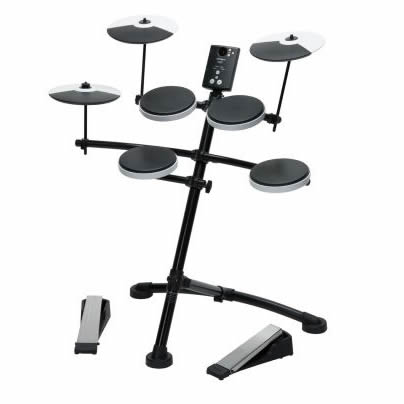
Roland TD-1K-V
£430
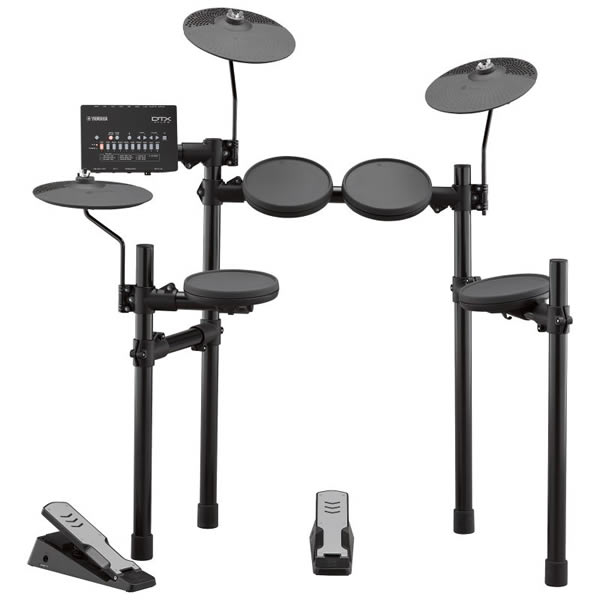
Yamaha DTX402
£335
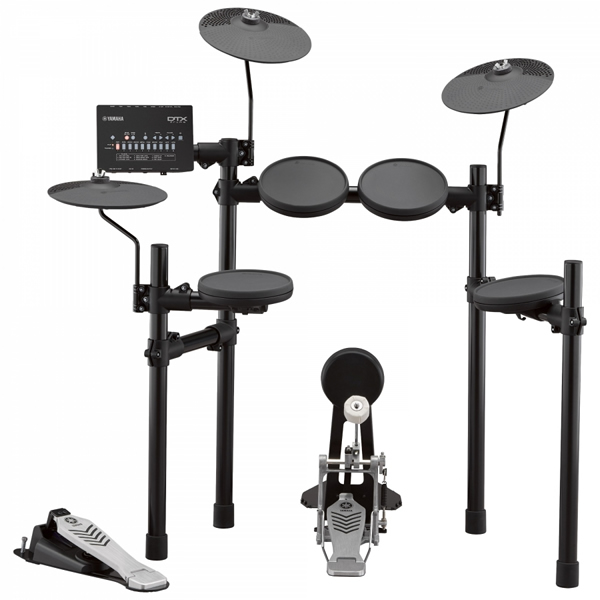
Yamaha DTX432
£449
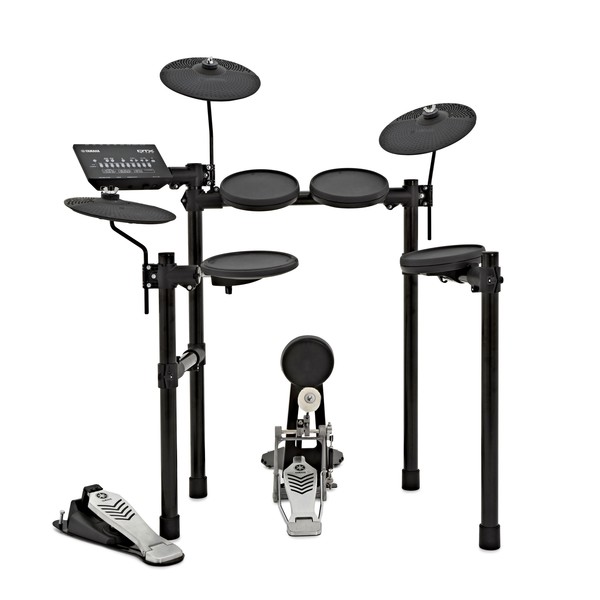
Yamaha 452
£449
Prices accurate of as 23rd September 2021
So I had already realised that Roland and Yamaha kits were not going to be an option for me because the kits with mesh heads were way out of my price range. The Roland and Yamaha kits that were within my budget looked very similar to my old Simmons e-drum kit with hard rubber pads and I wanted to upgrade to something closer to my old acoustic kit.
Oddly enough, if I had a bigger budget to play with of, say £1,500 to spend on a new electronic drum kit, my decision would have been much MUCH simpler, but as it turns out, having a budget of only £500 made this search a whole lot more tricky because there are actually quite a few different options for electronic drum kits in this price range – some I had heard of and some I had not.
2. Built-in Sounds
The built-in sounds needed to be good or at least reasonably good as I will be using it for gigging (as well as practicing at home). There are plenty of videos on YouTube of people connecting e-drum kits up to computers via MIDI and triggering VST drums (SSD5, EZDrummer, Superior Drummer etc) but for me, this wasn’t what I wanted to do as I am intending to use the kit for live performances and the built in sounds needed to sound good – I didn’t want to be faffing around with laptops and audio interfaces every time I gigged and, to be quite frank, these products are supposed to be e-drums, so they should sound like drums right! (More on that later.)
3. Playability
I used to play an acoustic kit years ago, so I wanted an electronic drum kit that could provide at least some level of realism when it came to playability; dual zone cymbals / ride was a really important factor in my checklist as I felt this would provide me with more options when playing and also a more realistic drumming experience.
Mesh heads were not a major factor for me though as I have been playing on a small hard rubber pad kit for 18 months before deciding to look for something better but I knew that I could get a kit with mesh heads for under £500, because I had been looking a few months beforehand to see if my £500 budget was actually realistic. I guess this is part of the reason why I dismissed the Roland and Yamaha kits with solid rubber pads early on in my search because I knew there were mesh kits available for under £500.
4. Durability / Portability
The kit needed to be reasonably durable and easy to collapse down and set up again making gigging as simple and painless as possible. Easy storage at home when not in use was also an important factor.
I spent several weeks trawling the internet for reviews of different kits and after great pains, I had narrowed my choice down to the following:
Tourtech TT-22M (£399)
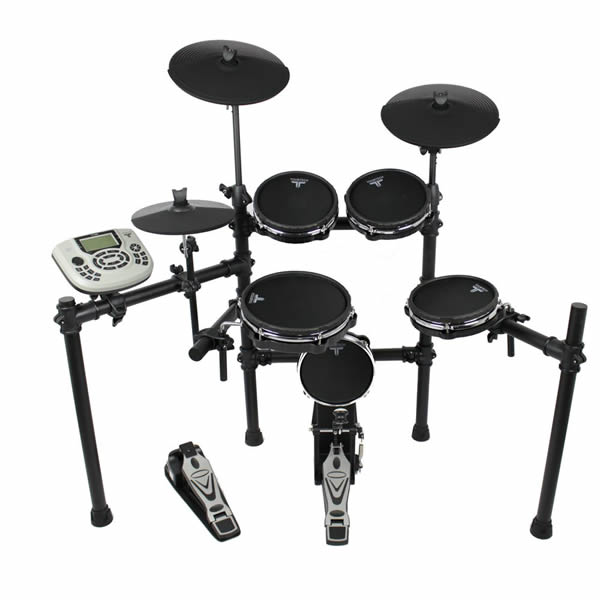
Alesis Nitro Mesh 5 Piece Kit (£299)
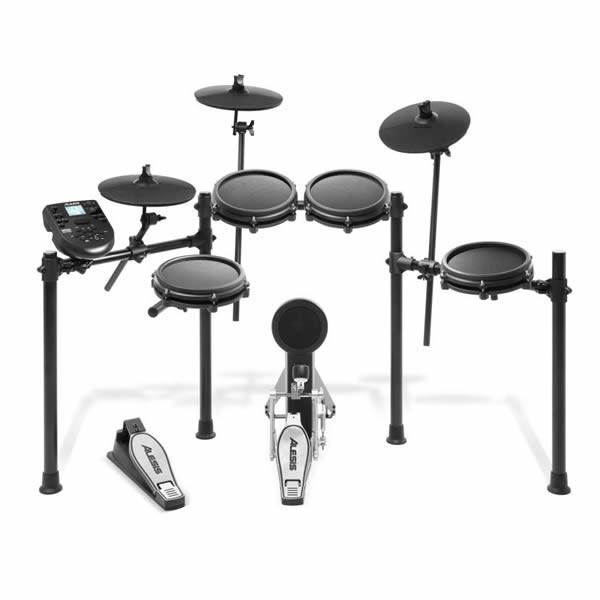
Millenium MPS-850 8 Piece Kit (£499)

Donner DED-200 (£320)
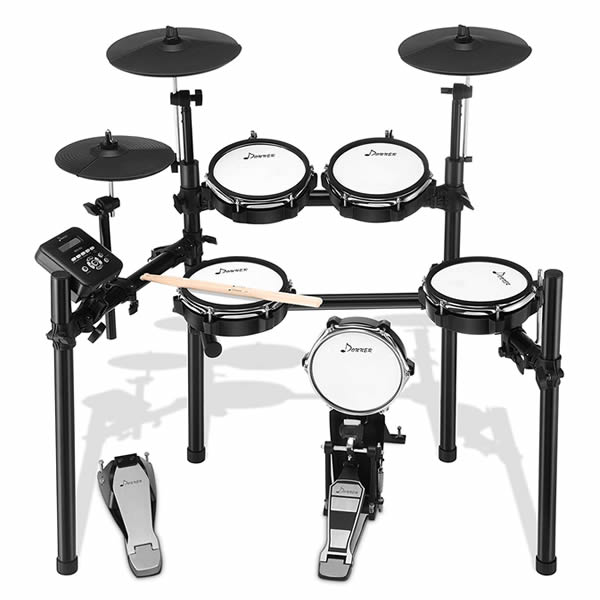
Alesis Crimson Mesh 2 (£688)
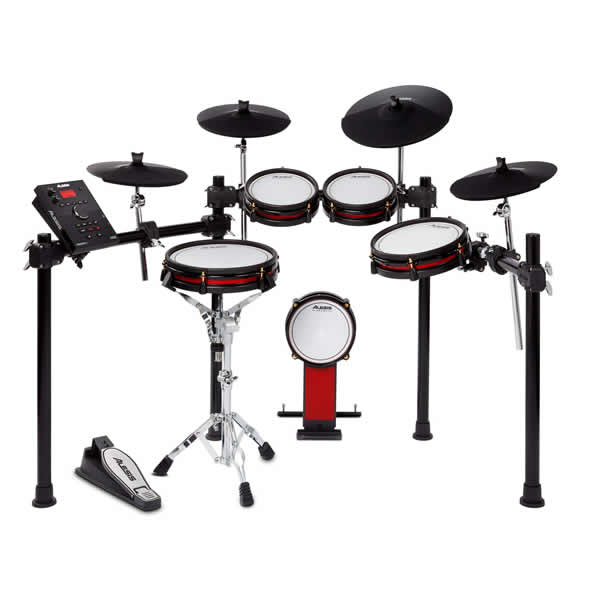
DD 470x Mesh (£399.99)
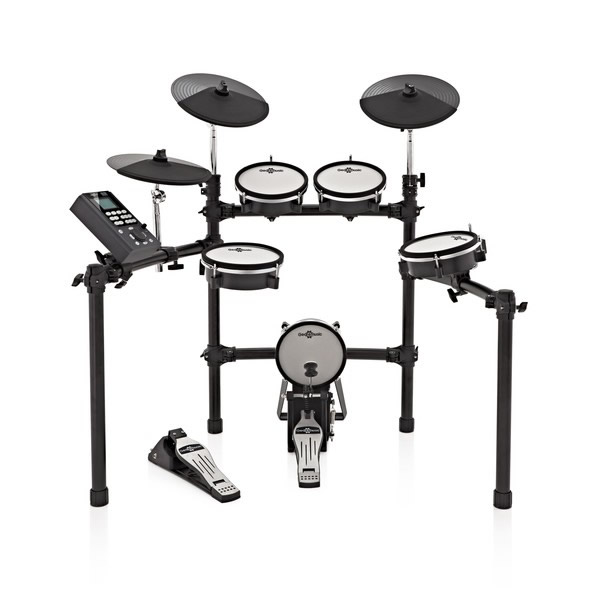
DD 480x Mesh (£549.99)
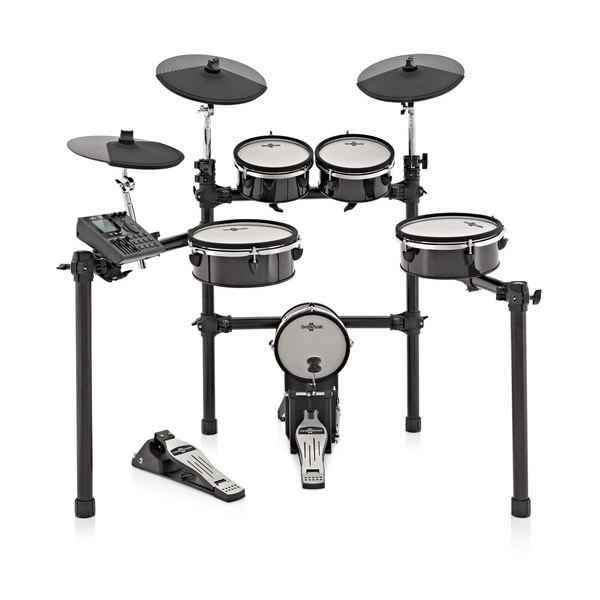
Out of these 7 drum kits, I put together a spreadsheet detailing all the features and specifications of each kit (pad / cymbal sizes, single/dual zone, price) and continued to search for additional user reviews of all these products.
All these kits have their merits, whether it’s based on price point or features or a mixture of both and I don’t intend to go into all the reasons why I dismissed most of these kits in this article, but let’s just say that after obsessive research and careful consideration, I narrowed this list down to just two kits:
Alesis Nitro Mesh
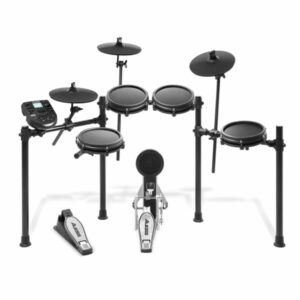
The Alesis Nitro Mesh option looked great and the standard 5 piece kit, while being ‘kind of’ adequate, could be upgraded with an additional tom and cymbal. The standard 5 piece kit is widely available online at £299 with the expansion kit being £89 which would add an additional tom pad and extra crash cymbal. The total cost for the upgraded 8 piece kit came in at £388, so well within my £500 budget. Alesis is an established brand and I have owned a few bits of Alesis hardware before (not drums though) so I felt comfortable considering this brand. For the purpose of this video, I will only be using the standard 5 piece Alesis Nitro Mesh kit.
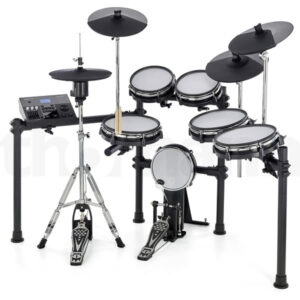 The Millenium MPS-850
The Millenium MPS-850
The Millenium MPS-850 kit was a wild card option that I found through my various searches and links on music forums etc. This kit is an ‘own brand’ drum kit sold by Thomann. This was not a brand I had ever heard of before, but the kit itself looked impressive and has a very high specification. The standard kit comes complete as an 8 piece kit including 4 x toms, 2 crash and 1 ride cymbal. The price for this kit was £499, so a bit more expensive than the Alesis kit, but still just within budget.
Something that was also quite apparent about the Millenium MPS-850 drum kit videos that I watched on YouTube, was the type of people who had bought this kit and published videos of themselves using it – many of them are actually very accomplished drummers, so this also gave me a certain sense of reassurance that this is a drum kit that I should consider.
Just as a side note: One thing I have learned throughout this whole process when I was paging through the reviews, comments and articles on these drum kits; it is really important to read between the lines. Trust your instincts and judgement and don’t be afraid to go against the norm. There are so many ‘brand snobs’ out there who own the more expensive kits by Roland and Yamaha who will continuously tell people to ‘save up and buy a Roland or Yamaha kit’, and that’s fine if you want to do that. But seriously, why would anyone want to spend more than they need to just because of a label?
Decision Time
I spent quite a while trying to decide which kit to buy to the point where it started getting annoying. For me, this was a major financial investment and I didn’t want to make the wrong choice. So which kit did I decide to go for in the end?
Well, as it happens, I just couldn’t decide, so I decided to buy both drum kits and set them both up in a head-to-head direct comparison. The websites where I bought the kits offered full, no quibble money back guarantees for at least 14 days, so I thought ‘what the heck’- I will keep the one I like the best and return the other one!
But I wanted to put together this video, to help other people who are going through the same decision as I was and provide you with my honest opinion on both of these e-drum kits in the hope that you are then able to make a more informed decision and avoid the sleepless nights that I had 🙂
So how do the two kits compare?
OK, so let’s get straight to it:
In the Box
Both kits appear to be made by the same manufacturer – I believe (from my research they are called ‘Medelli’). The individual boxes inside the main outer-box look almost identical as do the plastic bags that the hardware comes in.
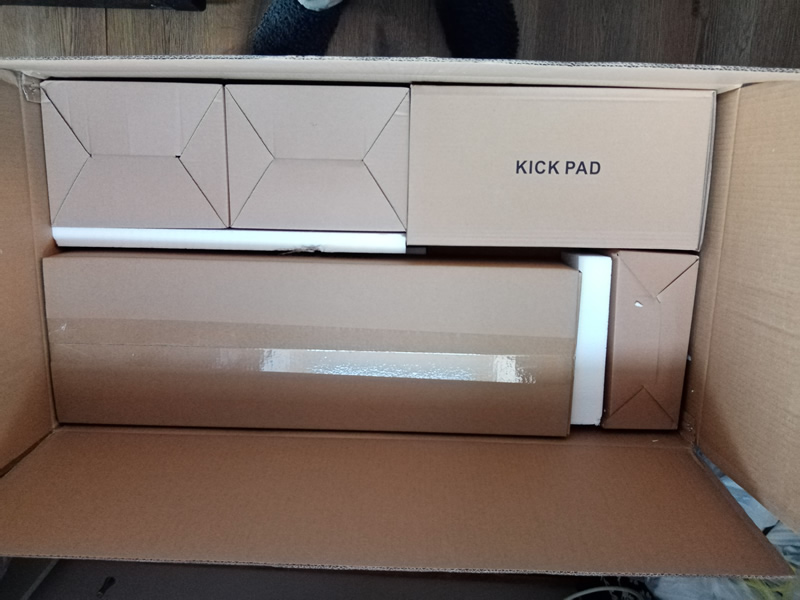
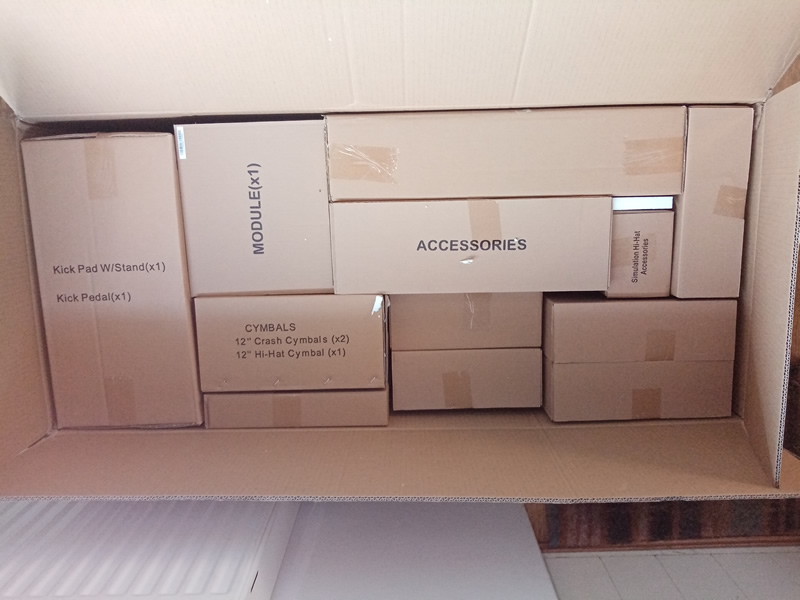
Unboxing First Impressions - the Pads and Cymbals
While unpacking both kits, the Millenium MPS-850 kit felt and looked to be a much, much higher quality product. There is serious weight in those cymbals and they feel (and look) amazing. The cymbals are 12” compared the 10” cymbals on the Alesis kit.
The Alesis Nitro Mesh kit felt cheap and the cymbals felt lightweight and almost toy-like. Sorry Alesis, but they just do :(. The Alesis 5 piece kit comes with 4 x 8” pads including 1 x snare, compared to the Millenium kit that has 3 x 10” pads including 1 x snare pad and 2 x 8” pads.
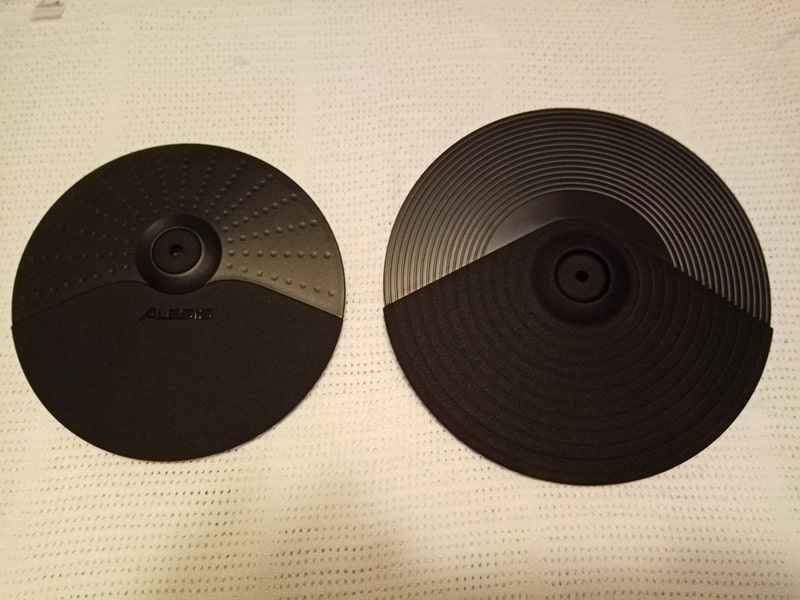
The Millenium MPS-850 Cymbal on the Right
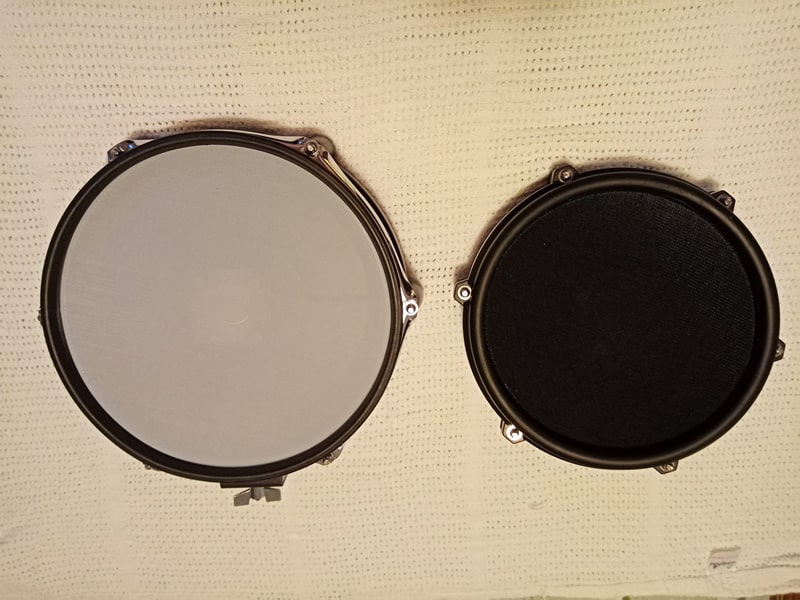
The Alesis Nitro Mesh Pad on the Right
Unboxing First Impressions - the Frame / Drum Rack
The Millenium MPS-850 frame wins hands down as it is just so much more solid, stronger and rigid than the Alesis Nitro Mesh kit frame. The drum rack frame tubing diameter is also larger on the Millenium MPS-850 kit making it ‘feel’ more like a ‘premium’ drum kit frame.
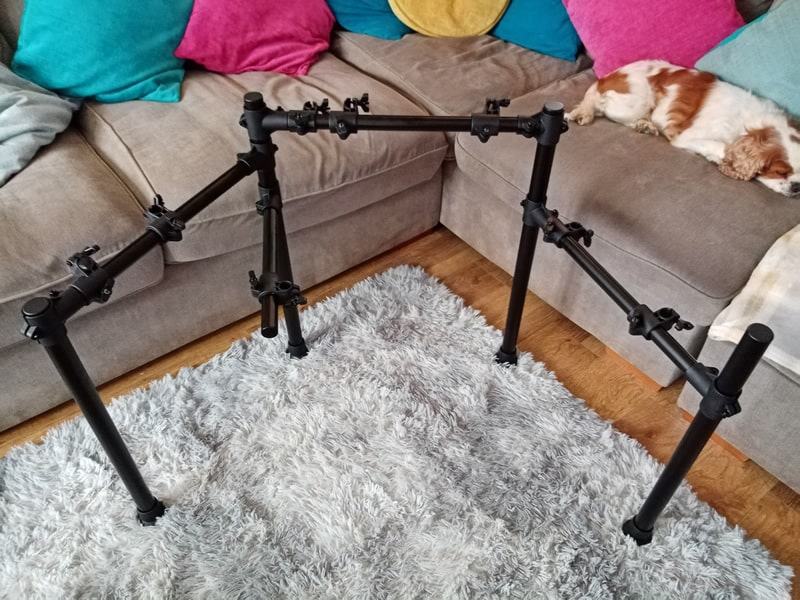
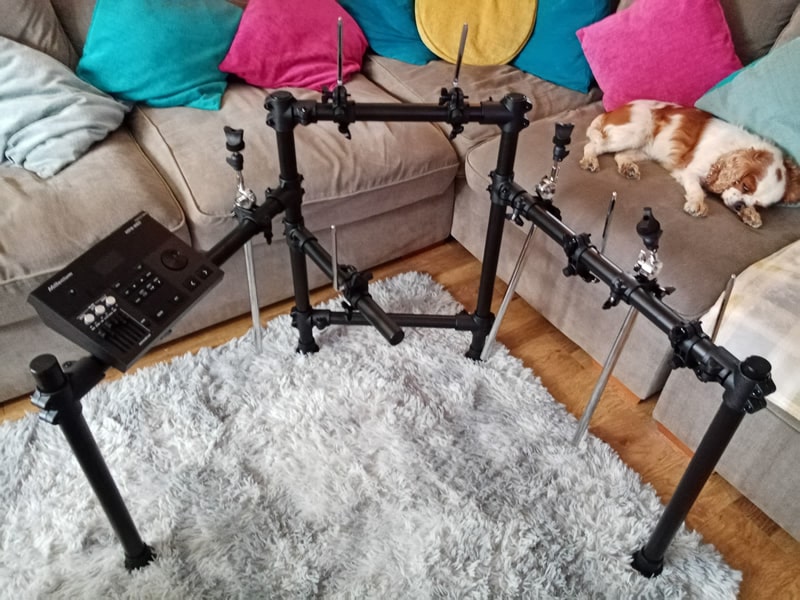
Setting Up
The Alesis Nitro Mesh kit took me about 40 minutes to set up. The Millenium MPS-850 kit took around 90 mins. As I needed my new drum kit for live performances, I was conscious of the fact that whichever kit I decided to go with, it would need some element of portability and having never owned an electronic drum kit with a frame before. setup time was in the back of my mind too.
As it happens, both kits are actually very portable, as the drum frame/rack on both kits can simply be folded in once you have removed the pads and cymbals – no issues here. The Alesis Nitro Mesh kit is probably slightly more portable than the Millenium MPS-850, but that’s because the frame is smaller/lighter and the pads/cymbals are also smaller than the Millenium MPS-850.


When fully assembled and all the pads and cymbals have been attached, the Millenium MPS-850 occupies more floor space than the Alesis Nitro Mesh kit and it is also taller than the Alesis kit overall.
Build Quality
This is where the differences REALLY start to set these two drum kits apart…
I was actually really surprised by the difference in the build quality between these two drum kits, especially as Alesis is a well established brand. I honestly thought that the build quality of the Alesis kit would be considerably higher than the Millenium MPS-850 as quite a few people have commented online that ‘you get what you pay for’ with the Millenium kit, but, in my opinion, this is most definitely not the case.
SIDE NOTE: There were also many people who were making this comment who admitted they had never heard of the Millenium MPS-850 drum kit, so how can their opinion of this kit even be valid?
Technical Specs - At a Glance
Alesis Nitro Mesh
The 4 x pads on the Alesis are all 8″ and the snare is dual zone. There are 3 x cymbals with this kit: 1 x hi-hat, 1 x crash and 1 x ride. All cymbals on the Alesis Nitro Mesh kit are 10″ and single zone.
Millenium MPS-850
Millenium MPS-850 has 5 x pads: 1 x 10″ snare, 2 x 8″ toms and 2 x 10″ floor toms. All the pads are dual zone.
There are 4 x cymbals with this kit: 1 x hi-hat, 2 x crash and 1 x ride. All cymbals on the Millenium MPS-850 are 12″ and dual zone.
Pad build quality appears initially to be comparable BUT the pads on the Alesis have a huge plastic rim which stands really proud of the mesh heads – more about this later.
Technical Specs - Cymbals - Crash and Ride
In my opinion, one of the major specification differences between the Alesis Nitro Mesh and the Millenium MPS-850 is the cymbal technology.
The Alesis Nitro Mesh 5 piece kit comes with 2 x cymbals – both are 10″ / single zone. 1 x crash and 1 x ride. It also comes with a single 10” hi-hat cymbal.
The Millenium MPS-850 comes with 2 x crash cymbals – both are 12″ dual-zone – and a ride cymbal which is 12″ and triple-zone. It also comes with 1 x hi-hat cymbal which is also 12”.

The Millenium MPS-850 Cymbal on the Right
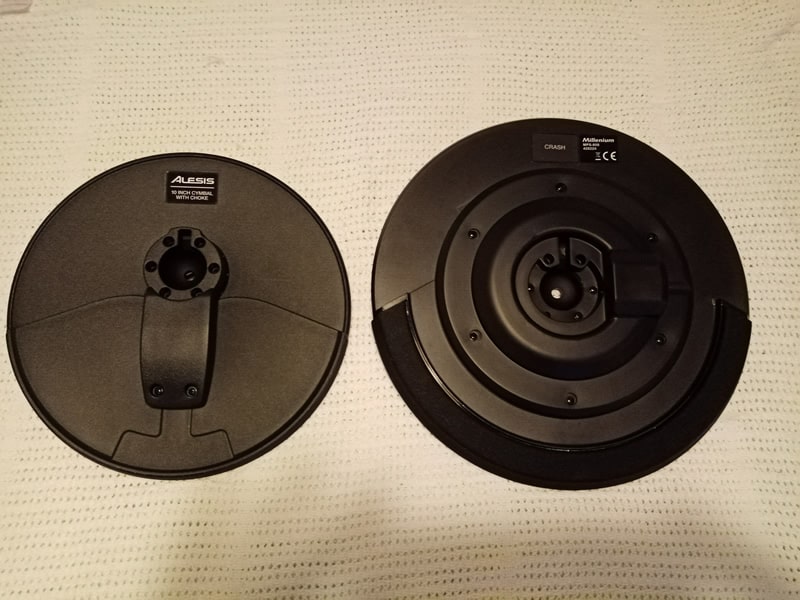
The Millenium MPS-850 Cymbal on the Right
One of the important requirements for me when looking for a new e-drum kit, was playability, especially when it comes to the cymbals. I love using my ride cymbal and for me, it just HAS to feel expressive and sound as realistic and as natural as possible.
In this regard, the Millenium MPS-850 cymbal specifications and playability wins hand down. The cymbals themselves play really well with a decent amount of weight across all 3 of them (I will come to the hi-hats later). The two crash cymbals (being dual zone) mean you can assign a different voice to both the edge and bow and adjust the volume of both independently. This provides greater expression and playing options. Both crash cymbals on the Millenium MPS-850 are chokable too.
The triple-zone (yes, triple-zone) ride cymbal on the Millenium MPS-850 is also excellent, and because it has three playing zones, it means you can assign different voices to the edge, bow and bell of the cymbal.
There are quite a few people who have complained online about the bell of the ride cymbal on the Millenium MPS-850 being difficult to trigger reliably. Personally, I just assigned a bell sound to the edge of the ride, which provided a very simple work-around for this issue (yes, the bell is tricky to get to fire reliably in my opinion), I then assigned a regular ride cymbal voice to the bow area of the cymbal – this configuration worked fine for my style of playing. I will continue to experiment with this to find that sweet spot on the cymbal where the bell can be triggered reliably.
The Alesis Nitro Mesh crash cymbal is single zone as is the ride cymbal, which for me, is a bit crap and quite frankly, very disappointing. The single zone really does limit your drumming finesse and expression when playing. The only realistic option for me would be to buy the Alesis Nitro Mesh expansion pack at £89 which would give me an extra tom and crash cymbal, but even then, the extra crash cymbal is only a single zone crash.
SIDENOTE: There are several articles on the internet by people who have discovered that the Alesis Nitro Mesh tom inputs on the tone module are actually dual-zone capable. It appears to be possible to change around the configuration of the cabling and add a dual-zone cymbal but plug it into the extra tom input on the drum module, essentially giving you a dual zone cymbal to play. Something to consider maybe if you are thinking of buying the Alesis Nitro Mesh kit?
So, the Millenium MPS-850 wins again when comparing the cymbal specification to the Alesis Nitro Mesh.
Technical Specs - Cymbals - Hi-hat
As I mentioned earlier in the article, I wasn’t too bothered about the hi-hats being clamped to the main drum rack or being a separate floor standing unit.
The Alesis Nitro Mesh hi-hat cymbal is clamped to the drum rack and has a single output cable to the voice module. The hi-hat pedal is a remote unit that sits underneath on the floor and also has a single output cable to the voice module. Playability of the Alesis Nitro Mesh hi-hat is actually OK and in some respects I prefer this to the Millenium MPS-850 hi-hat.
The Millenium MPS-850 hi-hat comes as a separate floor standing unit, which is almost identical to an acoustic drum kit hi-hat. A lot of people really like this feature and it does allow you to set up your kit in a way that feels most comfortable and natural. But, in regards to the hi-hat functionality itself, I found the Millenium MPS-850 hi-hats can be a little tricky to get setup and working properly.
It is obvious that there is some pretty advanced technology going on with this Millenium MPS-850 hi-hats and it may just be me getting used to it, but I have found that the triggering of the closed / open cymbal can be a little unpredictable at times. I have also found that I need to play slightly harder and precisely on the hi-hat than I would do on an acoustic kit, to make them trigger correctly. I found that the positioning of the top hi-hat cymbal makes a big difference here, so taking the time to get this setup properly is definitely worth the trouble.
The Millenium MPS-850 hi-hat also comes with a controller unit that sits directly underneath the bottom hi-hat cymbal. This is the technology that detects when the hi-hat is either open or closed and is controlled via the hi-hat foot pedal. The whole hi-hat setup on the Millenium MPS-850 looks and feels pretty much identical to a regular acoustic hi-hat.
Technical Specs - Kick & Snare
Both the Alesis Nitro Mesh and the Millenium MPS 850 kick drums come with a pedal included and both kick drums are free standing towers.
The Millenium MPS-850 kick drum pad is slightly larger at 10″ in comparison to the Alesis Nitro Mesh kick drum pad which is 8″. Both kick drums from both products work adequately but if you are planning on setting up either kit on a laminate or wood floor, you will need some type of grip mat underneath, to stop the pedal from moving around. In regards to the possibility of using a double-kick pedal for either kits, I wouldn’t know as I prefer a single pedal, but there are plenty of people who have made comments about this elsewhere on YouTube.
The snare pads on the two kits do have some major differences and this is a really big deal for me.
The Alesis Nitro Mesh snare is a dual zone 8″ mesh pad and the Millenium MPS-850 snare is a dual-zone 10″ mesh pad, so slightly bigger than the Alesis Nitro Mesh snare – no big deal. However, the Alesis snare (and also the toms) have a huge raised plastic rim that sits around 15mm proud around the edge of the mesh heads – totally ridiculous and this, for me, totally ruined the playability of the Alesis Nitro Mesh kit.
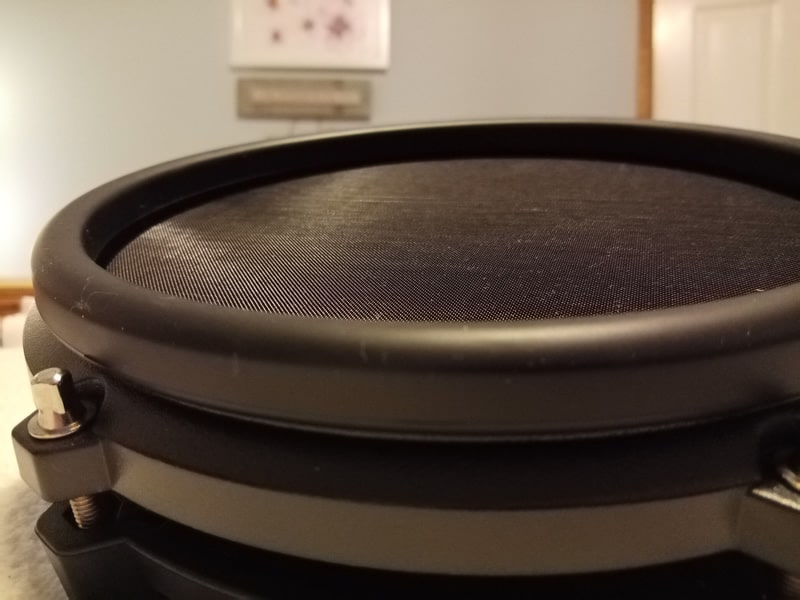
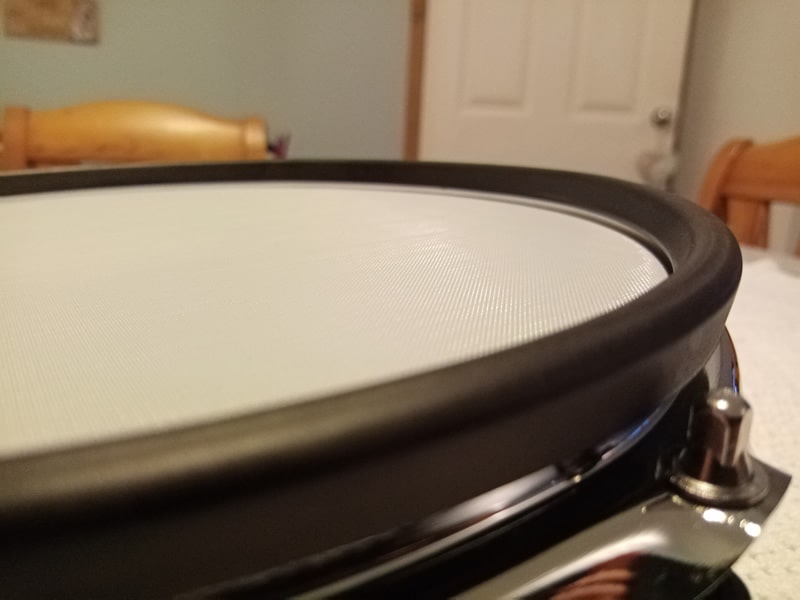
This plastic rim effectively prevents you from playing rim shots on the snare and the playing angle you need to set the snare at to avoid hitting the rims just feels plain awkward. This may just be me and my style of playing, but compared to the Millenium MPS-850 snare, the Alesis snare falls way short.
As with the snare on the Alesis Nitro Mesh kit, the toms on the Alesis kit also have these huge raised plastic rims around the pads, which really does affect the playability of all the pads. The only real option to get around this for me, was to angle the snare and toms on the Alesis kit down way more than I would do on an acoustic kit, so that I don’t keep hitting the rims.
On the Millenium MPS-850 kit, the snare and toms have a far more natural feel because the height/profile of the rim around the edge of the pads are much lower and I found the playability to be vastly better than the Alesis Nitro Mesh snare and toms.
So How Do The Two Kits Sound?
OK, I have a major gripe about both of these kits and about e-drums in general and then I won’t mention it again – promise.
Why oh why have these e-drum manufacturers filled up half of the the drum brain / tone module with stupid, useless sounds that nobody ever uses? If I want a marimba sound, I will buy a bloody marimba! And just don’t mention the ridiculous sound effect samples. What is THAT all about?
Surely when you buy an electronic drum kit, regardless of which brand you buy, you would expect to have a choice of some reasonable, well-crafted, professionally recorded, processed and acoustic drum kits that sound awesome straight out of the box right? Surely this is the very minimal requirement for any drum kit and the least most expensive part to produce?
(breathe) – so that’s my gripe over, so how do these two drum kits compare in relation to how they sound?
I must admit, I wasn’t expecting much from either Alesis Nitro Mesh or the Millenium MPS-850 after reading multiple articles and comments from people basically saying that the built-in sounds on both products sound terrible (“Roland / Yamaha are far superior” – I CAN’T AFFORD A BLOODY ROLAND OR YAMAHA KIT!) and the only way to get either of these drum kits to sound good, was to connect them up via MIDI and use a VST drum synth. I didn’t want to to be running a laptop alongside my drumkit, especially when playing live during gigs, so having reasonable built-in sounds was a really big deal for me.
So with quite low expectations from both of these units, I fired them up and tried out a few drum kits because this was one of the main determining factors for me – the built-in voices had to sound reasonable for live gigging.
The default kits on both the Alesis Nitro Mesh and the Millenium MPS-850 are indeed underwhelming, but when you start to get into creating your own kits, this is where one of the e-drum kits really starts to shine.
Realistically, I only actually need a couple of decent sounding kits:
Rock and Blues – Big fat snare, solid kick, deep pounding toms and bright, shimmering crashes
Pop – Punchy snare and kick, solid dull toms and bright short crashes.
That’s it – I’m easy to please and no, I don’t need a bloody marimba!
Creating your own kits on both the Millenium and the Alesis drum kits is actually really simple and intuitive. The Alesis Nitro Mesh comes with 392 built-in-sounds and the Millenium MPS-850 comes with 550 (although how many are actually usable in a drum kit is debatable? – sorry – gripe over!).
Both kits also have reverb that can be applied to each voice individually and the Millenium MPS-850 also has a compressor that can be applied to each drum kit as a whole to give your kits some added punch. After some fiddling around with the compressor on the Millenium MPS-850, I decided to keep it pretty much switched off, as I just couldn’t seem to work out if it actually was a compressor or just a weird dynamics/EQ setting.
Both kits also allow you to control the pitch, volume, pan of each voice along with sensitivity and velocity curve for each pad, which is handy for tweaking each drum kit to match your playing style. The Millenium MPS-850 also provides a tweakable decay setting for each voice (which when used properly, can actually give your drum kit more punch! – see SOUND DEMO – CUSTOM ROCK KIT).
Oh, and also, the Millenium MPS-850 allows you to upload your own samples to the voice module and assign them to the pads or cymbals – not something I have tried yet, but probably worth mentioning.
February 2022 UPDATE: I have used some custom WAV sounds on a few of my drumming videos on my YouTube channel. Have a look if you are interested: https://www.youtube.com/channel/UCbVCcTC2PiHmodJnTVwNdow
OK, so on to the sound demos. I admit that I am not the best drummer but I’m slowly getting back into it, so please forgive my playing 🙂
Videos
Recorded using the built-in-sounds on the Millenium MPS-850. Drum kit is a custom set using (what I think) are some of the best sounds.
Audio Only Files
Recorded using the built-in-sounds on the Alesis Nitro Mesh. Drum kit is a custom set using (what I think) are some of the best sounds from this module.
Alesis Nitro Mesh – Rock Kit
Millemium MPS-850 – Custom Pop Kit
Millemium MPS-850 – Custom Rock Kit
UPDATE 2022: My YouTube channel is a great for me to practice and (hopefully) improve my drumming. It gives me an excuse and the motivation to keep practicing.
So Which Kit Did I Keep?
I was expecting to be struggling to choose between these two drum kits, but I am so glad that I decided to get them both and try them out side-by-side because there is a very clear winner in my opinion.
I pretty much knew the instant I played on these two kits, that the Millenium MPS-850 is BY FAR the better kit for under £500. So why do I say this?
- Build Quality – Everything on the Millenium MPS-850 just feels like a premium product (including the power supply). By comparison, the Alesis kit feels more like a toy.
- Stability – The Millenium MPS-850 drum rack is bigger, heavier and more solid than the Alesis Nitro Mesh rack.
- Playability – The size of the Millenium MPS-850 snare, toms & cymbals, along with the dual/triple zone cymbals makes this kit very usable and it feels like a ‘proper’ drum kit. Again, the comparison, the Alesis Nitro Mesh kit feels flimsy and cheap.
- Technology – The technology that has gone into the Millenium MPS-850 is well beyond it’s price tag. The quality of the frame, pads and cymbals feel high-end as does the voice module too. By comparison, the Alesis Nitro Mesh hardware feels light and flimsy as does the voice module.
- Sound – The built-in drum samples on the Millenium MPS-850 and the Alesis Nitro Mesh modules are not breath-taking, I will admit to that. But I found the Millenium MSP-850 voices to be more usable and there are more to choose from. If you are looking for a seriously great electronic drumkit that has jaw dropping voices, you will need to spend a lot more money than £500. That said, I found that after playing around a bit with the Millenium’s settings and EQ, I could get a few pretty decent sounding kits out of it. The volume output on the Millenium’s headphone out is also much louder than the Alesis Nitro Mesh.
- Features – A few of the things I have found to be really useful on the Millenium MPS-850, especially when practicing with my band and performing live, are the individual volume faders for each of the pads and cymbals. The EQ and reverb settings are also very simple and usable and the AUX in (also available on the Alesis Nitro Mesh kit) is very handy when I fancy a bit of playing along at home.
What Put Me Off The Alesis Nitro Mesh?
The Alesis Nitro Mesh falls short of the Millenium MPS-850 is many ways:
- Alesis have understandably shave the cost off as many elements as possible, to hit their price point. This means that the whole package feels cheap.
- The drum frame wobbles quite a bit and is much more lightweight compared to the Millenium MPS-850.
- The cymbals are all single-zone (but the module itself will support dual zone tom inputs) so this does make playing on this kit feel limited.
- Raised pad rims – why Alesis made these so high (15mm?) is beyond me.
- Limited usable drum voices and some of them sound like they have been recorded in a cardboard box??
- The whole drum kit just feels very entry level and is probably more suited to a young person who is just starting drumming.
So if my budget had been more, would I have chosen something else?
Yes, of course. I would most likely have bought one of those very expensive Roland or Yamaha kits if I’m being completely honest because they sound incredible and if you have enough cash to throw around, you can get a Roland or Yamaha kit with all the bells and whistles.
But at £499, I think the Millenium MPS-850 is an absolutely fantastic drum kit that ticks all the boxes for me. It plays really well, looks great and sounds really rather good once you start playing around with creating your own kits.
So would I recommend this kit? Absolutely!
The Millenium MPS-850 electronic drum kit is only available to buy from Thomann. They deliver Wordwide and delivery to the UK took 5 days. Delivery times to other countries may vary.

